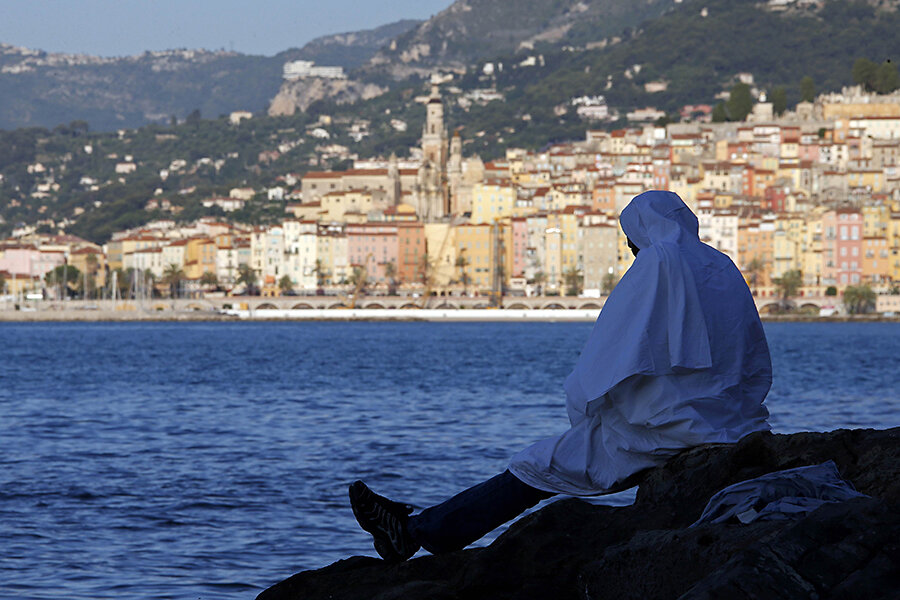Seeking Refuge: How the migration crisis is shaking Europe at its core
Loading...
| Paris and Rome
Much of Europe has been borderless for 20 years. That has meant no traffic jams when driving from France to Germany and no lines at airports when flying from Spain to Sweden.
But over the past week, along one stretch in southern Europe, French officials have begun checking passports to prevent a group of refugees from crossing into their territory from Italy.
Italy called France’s move a “slap in the face.” But this is more than just a dispute between two nations.
As Europe deals with an unprecedented influx of migrants from Africa and the Middle East, distrust is mounting between the European Union's member states. And much of that distrust, stirred up by populists, is shaking one of the core achievements of Europe: the Schengen agreement, which enshrined Europe's border-free living when it was conceived of 30 years ago this week.
“This is a much wider problem than Schengen, but Schengen is the victim because it becomes a symbol of all the fears, that we are defenseless,” says Marc Pierini, a visiting scholar on European policy at Carnegie Europe in Brussels. “The 30-year anniversary occurs in the middle of a political and security crisis of major proportions that spans from Mali to Iraq.”
Showdown on the Riviera
Italian police in riot gear on Tuesday rounded up some 300 migrants who had set up temporary camp on the rocky seashore between Italy and France. They had been protesting France’s refusal to let them cross the frontier and move onto wealthier nations of Europe where they have family and jobs are more plentiful.
EU rules allow governments to temporarily reintroduce border checks within the Schengen zone if they argue that their national security is at risk. But those rules also stipulate that asylum-seekers must have their cases processed in the country where they first set foot. Italy, where most land, has for years flouted the requirement. Instead, it turns a blind eye to migrants who simply walk out of refugee reception centers and head toward northern Europe by road and rail, or even on foot. Officials from both France and Italy accused the other of not following the rules.
Matteo Renzi, the Italian prime minister, threatened in a local newspaper on Sunday to implement a "Plan B" to deal with the migrant crisis that would "hurt" Europe if Italy’s border continued to be blocked by France. He didn’t specify his actions, but Italian media speculated that he planned on issuing Schengen visas to allow migrants to move freely on.
More than 170,000 migrants reached Italy from Libya last year, and so far this year the total is about 57,000, with the country’s reception centers close to breaking point.
Debate over Schengen
Ministers from France, Italy, and Germany meeting in Luxembourg Tuesday gave their support to a plan to relocate asylum-seekers across Europe using a quota system, or swiftly return them home if their claims are rejected. That deal will be discussed at a European summit in Brussels next week.
But the quota concept faces deep skepticism from many eastern countries in Europe. And even with an agreement, it only addresses a fraction of those trying to enter Europe. And flashpoints like that on the French-Italian border – and a similar one along Italy’s border with Austria – could flare up again elsewhere.
This is not the first time Schengen, which today includes 26 countries, has been under fire or used as a threat. When the agreement was signed in 1985, Europe was much smaller and much more economically homogenous. When the European Union expanded to include many post-Soviet and poorer countries in the East, many of those citizens migrated for job opportunities in the richer West, raising resentments that still play out in political elections today.
This year, concerns about terrorism in the wake of the Charlie Hebdo attacks in Paris and the return of European jihadis from Syria and Iraq, have put the concept of a border-free Europe under a harsh spotlight. Politics comes into play as well: Greek officials in March threatened to unleash a “wave of economic migrants” and jihadists if Greece's European creditors did not back down on austerity demands on the near-bankrupt country.
But it’s migration that has tested Schengen the most.
Brinkmanship?
Strains first started showing with the influx of migrants in the wake of the Arab Spring. In 2011, France first closed its borders to migrants in Italy, and the leaders of both countries pushed the EU to adopt new rules regarding the re-imposition of border checks, says Steve Peers, a professor of EU law at the University of Essex in the UK.
In part, the threats issued by Italy recently could be brinkmanship to force Europe to share the burden, he says. “They have tried being nice, and it hasn’t worked,” he says. “They feel a little bit desperate.”
Still, he says that Schengen is vulnerable today because of the sheer scale of a migration pattern that shows no sign of abating.
Simen Ekern, a Norwegian specialist on European affairs, says he believes Schengen is safe because its advantages outweigh its disadvantages, but that it is getting exploited for domestic consumption.
“The French want to show to their electorate that they are doing something about immigration," he says. "Italy, meanwhile, wants to put pressure on the rest of Europe to accept a quota system for accepting refugees.”
Europe's various far-right groups have been most vocal about fortifying borders.
Matteo Salvini, the head of the xenophobic, anti-immigration Northern League party in Italy, congratulated France for increasing passport checks, for example. “The French are doing well to defend their borders. I wish our government would do the same. Italy can no longer continue to act as a hotel for clandestine migrants,” he said.







